Biology > TEST BANK > Test Bank for Nester’s Microbiology: A Human Perspective 8th Edition Anderson (All chapters comple (All)
Test Bank for Nester’s Microbiology: A Human Perspective 8th Edition Anderson (All chapters complete, Question and Answers,
Document Content and Description Below
Test Bank for Nester’s Microbiology: A Human Perspective 8th Edition Anderson (All chapters complete, Question and Answers, Newly updated 2021) Test Bank for Nester’s Microbiology: A Human Perspe... ctive 8th Edition Anderson Nesters Microbiology A Human Perspective 8th Edition Anderson Test Bank This is NOT the TEXT BOOK. You are buying TEST BANK for Nesters Microbiology A Human Perspective 8th Edition by Anderson. Test Bank comes in a PDF or Word format and available for download only. Nesters Microbiology A Human Perspective 8th Edition Anderson Anderson Test Bank with answers of this Test Bank only NO Solutions Manual for the Text book included on this purchase. If you want the Solutions Manual please search on the search box. All orders are placed anonymously. Your purchase details will be hidden according to our website privacy and be deleted automatically. Sample: Nesters Microbiology A Human Perspective 8th Edition Anderson Test Bank Chapter 02 - The Molecules of Life Chapter 02 The Molecules of Life Multiple Choice Questions 1. In addition to investigations with bacteria that led to him being considered the Father of Microbiology, Pasteur also A. found that some molecules can exist as stereoisomers. B. created aspartame. C. separated organic acids using a microscope. D. discovered polarized light. E. found that some molecules can exist as stereoisomers AND separated organic acids using a microscope. Bloom's Level: 1. Remember Learning Outcome: 02.01 Section: 02.01 Topic: Chemistry 2. The negatively charged component of the atom is the A. proton. B. nucleus. C. neutron. D. electron. Bloom's Level: 1. Remember Learning Outcome: 02.01 Section: 02.01 Topic: Chemistry 2-1 Copyright © 2016 McGraw-Hill Education. All rights reserved. No reproduction or distribution without the prior written consent of McGraw-Hill Education. 3. The part of the atom that is most involved in chemical reactivity is the A. proton. B. neutron. C. electron. D. nucleus. Bloom's Level: 2. Understand Learning Outcome: 02.01 Section: 02.01 Topic: Chemistry 4. Electrons A. are found in areas outside the nucleus known as orbitals. B. may gain or lose energy. C. may move from one orbital to another. D. are located farthest from the nucleus and have the least energy. E. are found in areas outside the nucleus known as orbitals, may gain or lose energy, and may move from one orbital to another. Bloom's Level: 1. Remember Learning Outcome: 02.01 Section: 02.01 Topic: Chemistry Check All That Apply Questions 5. The atomic number for an atom of a specific element is equal to (Check all that apply) X the number of electrons in a single atom of that element. the number of electrons plus neutrons in a single atom of that element. X the number of protons in a single atom of that element. the number of neutrons and protons in a single atom of that element. Bloom's Level: 1. Remember Learning Outcome: 02.01 Section: 02.01 Topic: Chemistry Multiple Choice Questions 6. Sharing of electrons between 2 atoms forms a(n) A. hydrogen bond. B. ionic bond. C. covalent bond. D. strong bond. E. covalent bond AND strong bond. Bloom's Level: 2. Understand Learning Outcome: 02.03 Section: 02.02 Topic: Chemistry 7. If electrons are gained or lost in the formation of a bond, the bond is termed A. covalent. B. hydrogen. C. ionic. D. nonpolar. Bloom's Level: 2. Understand Learning Outcome: 02.03 Section: 02.02 Topic: Chemistry 8. Charged atoms are termed A. ions. B. neutrons. C. molecules. D. polymers. Bloom's Level: 1. Remember Learning Outcome: 02.03 Section: 02.02 Topic: Chemistry 9. Water A. is a polar molecule. B. is referred to as a universal solvent. C. makes up over 70% (by wt.) of an organism. D. is often a product or reactant in chemical reactions. E. All of the choices are correct. Bloom's Level: 2. Understand Learning Outcome: 02.05 Section: 02.03 Topic: Chemistry 10. pH A. is a measure of the hydrogen ion concentration. B. utilizes a scale from 5 to 8. C. is a linear (not logarithmic) scale. D. is an abbreviation for "power of helium." E. is a measure of the hydrogen ion concentration, utilizes a scale from 5 to 8, AND is a linear (not logarithmic) scale. Bloom's Level: 2. Understand Learning Outcome: 02.06 Section: 02.03 Topic: Chemistry 11. The subunits (building blocks) of proteins are A. nucleotides. B. phospholipids. C. amino acids. D. carbohydrates. Bloom's Level: 1. Remember Learning Outcome: 02.10 Section: 02.04 Topic: Chemistry 12. If the side chains of amino acids contain carboxyl (-COOH) groups, they A. contribute a positive charge to the amino acid at pH 10. B. contribute a negative charge to the amino acid at pH 10. C. have no effect on the charge of the amino acid at pH 10. D. are considered acidic amino acids. E. contribute a negative charge to the amino acid at pH 10 AND are considered acidic amino acids. Bloom's Level: 3. Apply Learning Outcome: 02.10 Section: 02.04 Topic: Chemistry 13. Amino acids that contain many methyl (-CH3) groups A. are considered hydrophilic. B. are non-polar. C. carry a positive charge. D. carry a negative charge. E. are considered hydrophilic AND carry a positive charge. Bloom's Level: 3. Apply Learning Outcome: 02.10 Section: 02.04 Topic: Chemistry 14. D-amino acids are associated with A. radioactive isotopes. B. human proteins. C. plant proteins. D. bacterial cell walls. Bloom's Level: 1. Remember Learning Outcome: 02.10 Section: 02.04 Topic: Chemistry 15. The most important feature of a protein is its A. secondary structure. B. side group. C. shape. D. electric charge. Bloom's Level: 2. Understand Learning Outcome: 02.11 Section: 02.04 Topic: Chemistry 16. The helices and sheets of amino acids form a protein's A. primary structure. B. secondary structure. C. tertiary structure. D. quaternary structure. Bloom's Level: 1. Remember Learning Outcome: 02.11 Section: 02.04 Topic: Chemistry 17. Acidic or basic amino acids are A. readily soluble in water. B. readily soluble in lipids. C. able to form ions. D. considered hydrophilic. E. readily soluble in water, able to form ions, AND considered hydrophilic. Bloom's Level: 2. Understand Learning Outcome: 02.10 Section: 02.04 Topic: Chemistry 18. The N terminal in a protein A. is the end characterized by a free carboxyl group. B. is the end characterized by a free amino group. C. is typically found in the middle of a protein. D. refers to that area of a protein that is bound to another protein. Bloom's Level: 1. Remember Learning Outcome: 02.10 Section: 02.04 Topic: Chemistry 19. Protein denaturation can A. occur due to certain chemicals. B. occur due to pH changes. C. occur due to high temperature. D. cause the protein to no longer function. E. All of the choices are correct. Bloom's Level: 2. Understand Learning Outcome: 02.11 Section: 02.04 Topic: Chemistry 20. Which is true of carbohydrates? A. They may be part of the structure of bacteria. B. They may serve as a source of food. C. They contain carbon, hydrogen, and oxygen in a 1:2:1 ratio. D. They may be bonded to proteins to form glycoproteins. E. All of the choices are correct. Bloom's Level: 2. Understand Learning Outcome: 02.12 Section: 02.05 Topic: Chemistry 21. Carbohydrates A. form only ring structures. B. form only linear structures. C. may interconvert between ring and linear structures. D. contain both ring and linear portions within the same molecule. Bloom's Level: 2. Understand Learning Outcome: 02.13 Section: 02.05 Topic: Chemistry 22. Structural isomers A. contain the same number of atoms/elements, but in different arrangements. B. are exemplified by glucose and galactose. C. are formed by different arrangements of the -COOH groups. D. may be referred to as the -D and -L forms. E. contain the same number of atoms/elements, but in different arrangements AND are exemplified by glucose and galactose. Bloom's Level: 3. Apply Learning Outcome: 02.13 Section: 02.05 Topic: Chemistry 23. What type of bonding holds one strand of DNA to the complementary strand of DNA? A. Covalent B. Hydrogen C. Disulfide D. Ionic Bloom's Level: 2. Understand Learning Outcome: 02.14 Section: 02.06 Topic: Chemistry 24. The sugars found in nucleic acids consist of A. 3 carbon atoms. B. 5 carbon atoms. C. 7 carbon atoms. D. 9 carbon atoms. Bloom's Level: 1. Remember Learning Outcome: 02.14 Section: 02.06 Topic: Chemistry 25. Which of the following is found in RNA but not in DNA? A. Adenine B. Ribose C. Thymine D. Uracil E. Ribose AND Uracil Bloom's Level: 2. Understand Learning Outcome: 02.14 Section: 02.06 Topic: Chemistry 26. Which shows the incorrect complementary base pairing? A. A:T B. G:C C. G:T D. A:U E. A:T, G:C, AND A:U Bloom's Level: 3. Apply Learning Outcome: 02.14 Section: 02.06 Topic: Chemistry 27. The components of fats are fatty acids and A. amino acids. B. nucleotides. C. phosphate. D. glycerol. E. All of the choices are correct. Bloom's Level: 1. Remember Learning Outcome: 02.15 Section: 02.07 Topic: Chemistry 28. 28. In general, when saturated fats are compared to unsaturated fats (assuming the same number of carbon atoms in the molecule), A. they have about the same melting temperature. B. saturated fats have a lower melting temperature. C. unsaturated fats have a lower melting temperature. D. No generalizations can be made since melting temperature is strongly influenced by other factors. Bloom's Level: 3. Apply Learning Outcome: 02.15 Section: 02.07 Topic: Chemistry True / False Questions 29. If you placed the molecule in a vertical orientation, then from top to bottom, the two parallel strands of DNA are both oriented in the same, 5 to 3, direction. FALSE Bloom's Level: 2. Understand Learning Outcome: 02.14 Section: 02.06 Topic: Chemistry 30. RNA is a long double-stranded helix containing ribose and uracil. FALSE Bloom's Level: 1. Remember Learning Outcome: 02.14 Section: 02.06 Topic: Chemistry 31. Lipids, like nucleic acids and proteins, are made of strings of similar subunits. FALSE Bloom's Level: 2. Understand Learning Outcome: 02.15 Section: 02.07 Topic: Chemistry 32. Steroids are simple lipids. TRUE Bloom's Level: 2. Understand Learning Outcome: 02.15 Section: 02.07 Topic: Chemistry 33. 33. Water-soluble substances easily pass through the phospholipid bilayer of a cell membrane. FALSE Bloom's Level: 2. Understand Learning Outcome: 02.15 Section: 02.07 Topic: Chemistry Multiple Choice Questions 34. The positively charged component of the atom is the A. electron. B. neutron. C. proton. D. quark. Bloom's Level: 1. Remember Learning Outcome: 02.01 Section: 02.01 Topic: Chemistry 35. The uncharged component of the atom is the A. electron. B. proton. C. neutron. D. muon. Bloom's Level: 1. Remember Learning Outcome: 02.01 Section: 02.01 Topic: Chemistry 36. Which determines the chemical and physical properties of an atom of an element? A. Electron B. Neutron C. Atomic weight D. Atomic number Bloom's Level: 2. Understand Learning Outcome: 02.01 Section: 02.01 Topic: Chemistry 37. The atom, as a whole, is uncharged because A. the number of protons equals the number of neutrons. B. the number of electrons equals the number of neutrons. C. neutrons neutralize the charges. D. the number of protons equals the number of electrons. Bloom's Level: 2. Understand Learning Outcome: 02.01 Section: 02.01 Topic: Chemistry 38. The atomic weight is equal to A. the number of electrons. B. the number of electrons plus neutrons. C. the number of protons. D. the number of neutrons and protons. Bloom's Level: 1. Remember Learning Outcome: 02.01 Section: 02.01 Topic: Chemistry 39. If electrons are shared unequally, this forms a(n) A. weak bond. B. non-polar bond. C. polar bond. D. ionic bond. Bloom's Level: 2. Understand Learning Outcome: 02.03 Section: 02.02 Topic: Chemistry 40. Atoms that gain electrons are now A. positively charged. B. negatively charged. C. neutral. D. lighter. Bloom's Level: 2. Understand Learning Outcome: 02.02 Section: 02.02 Topic: Chemistry 41. Which of these bonds are weak individually but are much stronger as a group? A. Covalent B. Ionic C. Neutron D. Hydrogen E. Ionic AND Hydrogen Bloom's Level: 3. Apply Learning Outcome: 02.03 Section: 02.02 Topic: Chemistry 42. The most important molecule(s) in the world is(are) A. water. B. protein. C. carbohydrates. D. nucleic acids. Bloom's Level: 2. Understand Learning Outcome: 02.08 Section: 02.03 Topic: Chemistry 43. The energy storage form of ATP A. contains deoxyribose. B. contains ribose. C. contains a pyrimidine base. D. readily releases energy by breaking the bond between the base and the sugar. E. contains deoxyribose, contains a pyrimidine base, AND readily releases energy by breaking the bond between the base and the sugar. Bloom's Level: 1. Remember Learning Outcome: 02.07 Section: 02.03 Topic: Chemistry 44. How many different amino acids are there to choose from when assembling a protein? A. 5 B. 10 C. 20 D. 25 Bloom's Level: 1. Remember Learning Outcome: 02.10 Section: 02.04 Topic: Chemistry 45. If the side chains of amino acids contain the ammonium ion, they readily form ions that A. are described as acidic amino acids. B. give positive electric charges to the amino acid. C. are described as basic amino acids. D. react with lipids to form lipoproteins. E. give positive electric charges to the amino acid AND are described as basic amino acids. Bloom's Level: 3. Apply Learning Outcome: 02.10 Section: 02.04 Topic: Chemistry 46. L-amino acids occur in proteins and are designated A. unnatural. B. natural. C. rare. D. left handed. E. natural AND left handed. Bloom's Level: 2. Understand Learning Outcome: 02.10 Section: 02.04 Topic: Chemistry 47. Amino acids in proteins are linked to one another by peptide bonds between the A. methyl group of one amino acid and a side group of another amino acid. B. carbon atoms of two adjacent amino acids. C. carboxyl group of one amino acid and the amino group of another. D. nitrogen atom and carboxyl ion. Bloom's Level: 2. Understand Learning Outcome: 02.11 Section: 02.04 Topic: Chemistry 48. The primary structure in a protein A. refers to the helical folding of a protein. B. refers to two or more polypeptides linked to one another. C. refers to the sequence of amino acids. D. refers to the initial folding of a protein. Bloom's Level: 1. Remember Learning Outcome: 02.11 Section: 02.04 Topic: Chemistry 49. Side chains are important to proteins because they A. help determine protein shape. B. help determine the degree of solubility of the protein in water. C. are a source of energy for hydration reactions in the cell. D. form the peptide bonds that link amino acids to one another. E. help determine protein shape AND help determine the degree of solubility of the protein in water. Bloom's Level: 3. Apply Learning Outcome: 02.10 Section: 02.04 Topic: Chemistry 50. A protein A. assumes any number of equally functional shapes. B. may need help, in the form of chaperones, to assume the correct shape. C. consists of a string of hydroxyl acids. D. is always polar. E. assumes any number of equally functional shapes AND may need help, in the form of chaperones, to assume the correct shape. Bloom's Level: 2. Understand Learning Outcome: 02.11 Section: 02.04 Topic: Chemistry 51. Weak bonds are important for the structure of proteins. A. primary B. secondary C. tertiary D. quarternary E. secondary, tertiary, AND quarternary Bloom's Level: 2. Understand Learning Outcome: 02.11 Section: 02.04 Topic: Chemistry 52. Proteins A. are involved in almost every important function performed by a cell. B. comprise more than 50% of the dry weight of a cell. C. are composed of a string of nucleotides. D. are characterized by a 1:2:1 ratio of carbon to hydrogen to oxygen. E. are involved in almost every important function performed by a cell AND comprise more than 50% of the dry weight of a cell. Bloom's Level: 2. Understand Learning Outcome: 02.09 Section: 02.04 Topic: Chemistry 53. The carbohydrate(s) found in nucleic acids is/are A. ribose. B. glucose. C. galactose. D. deoxyribose. E. ribose AND deoxyribose. Bloom's Level: 1. Remember Learning Outcome: 02.12 Section: 02.05 Topic: Chemistry 54. The -OH group in a carbohydrate A. may be found above or below the plane of the ring. B. is involved in the formation of stereoisomers. C. is involved when linking monosaccharides together. D. All of the choices are true. Bloom's Level: 2. Understand Learning Outcome: 02.13 Section: 02.05 Topic: Chemistry 55. Dehydration reactions are involved in A. the formation of polypeptides. B. the formation of polysaccharides. C. the formation of monosaccharides. D. the formation of nucleotides. E. the formation of polypeptides AND the formation of polysaccharides. Bloom's Level: 2. Understand Learning Outcome: 02.10 Section: 02.04 Topic: Chemistry 56. Which is true of nucleotides? A. They are the building blocks of DNA. B. They carry chemical energy in their bonds. C. They are part of certain enzymes. D. They serve as specific signaling molecules. E. All of the choices are true. Bloom's Level: 2. Understand Learning Outcome: 02.14 Section: 02.06 Topic: Chemistry 57. The purines of DNA are A. adenine and guanine. B. thymine and adenine. C. serine and threonine. D. thymine and uracil. E. thymine and adenine AND thymine and uracil. Bloom's Level: 1. Remember Learning Outcome: 02.14 Section: 02.06 Topic: Chemistry 58. The end of the nucleic acid chain that grows by adding more nucleotides is always the A. 5 prime end. B. C terminal. C. N terminal. D. 3 prime end. Bloom's Level: 2. Understand Learning Outcome: 02.14 Section: 02.06 Topic: Chemistry 59. The characteristic common to all lipids is their A. solubility in organic solvents. B. hydrophilic nature. C. large size. D. hydrophobic nature. E. solubility in organic solvents AND hydrophobic nature. Bloom's Level: 2. Understand Learning Outcome: 02.15 Section: 02.07 Topic: Chemistry 60. 60. Which is (are) true of lipids? A. They are a major structural element of all cell membranes. B. They act as gatekeepers of the cell. C. They demark the inside vs. the outside of the cell. D. They are a heterogeneous group of molecules. E. All of the choices are correct. Bloom's Level: 2. Understand Learning Outcome: 02.15 Section: 02.07 Topic: Chemistry True / False Questions 61. As DNA is always double-stranded, RNA is always single-stranded. FALSE Bloom's Level: 2. Understand Learning Outcome: 02.14 Section: 02.06 Topic: Chemistry 62. Lipids are polar, hydrophilic molecules. FALSE Bloom's Level: 2. Understand Learning Outcome: 02.15 Section: 02.07 Topic: Chemistry 63. Simple lipids contain carbon, hydrogen, and oxygen in a 1:2:1 ratio. FALSE Bloom's Level: 1. Remember Learning Outcome: 02.15 Section: 02.07 Topic: Chemistry 64. 64. Phospholipids are non-polar molecules. FALSE Bloom's Level: 1. Remember Learning Outcome: 02.15 Section: 02.07 Topic: Chemistry 65. Unsaturated fats have lower melting points than saturated fats. TRUE Bloom's Level: 3. Apply Learning Outcome: 02.15 Section: 02.07 Topic: Chemistry Multiple Choice Questions 66. 66. Microorganisms use hydrogen bonds to attach themselves to the surfaces that they live upon. Many of them lose hold of the surface because of the weak nature of these bonds and end up dying or being washed away. Why don't microbes just use covalent bonds instead? A. Covalent bonds are always permanent bonds; the microbes could never get OFF their surface if they used them. B. Covalent bonds depend on completely giving up or completely accepting an electron to form the bond. This isn't possible for many microbes without dramatically altering their basic molecular composition. C. Covalent bonds typically require enzymes to form/break, whereas hydrogen bonds don't. If covalent bonds were used, it would require much more energy and molecules to be contributed from the cell. Hydrogen bonds don't have these requirements. D. Covalent bonds may have more specific and stringent requirements for what atoms can bond with. This makes for stronger bonds, but also decreases the overall potential for bonds that could readily be created between the microbe and its desired surface. E. C and D Bloom's Level: 5. Evaluate Learning Outcome: 02.03 Section: 02.02 Topic: Chemistry Nesters Microbiology A Human Perspective 8th Edition Anderson Test Bank Chapter 02 - The Molecules of Life 67. 67. A biologist determined the amounts of several amino acids in two separate samples of pure protein. His data stated that Protein A possessed: 7% leucine, 12% alanine, 4% histidine, 2% cysteine, and 5% glycine. Interestingly, Protein B had the same percentages of each of the same amino acids. He concluded, from this data, that Proteins A and B are the same protein. Based on this information and his conclusion, determine which of the following is the correct statement regarding his findings: A. He is correct; they have the same percentages of each amino acid, so they are identical protein molecules. B. He is incorrect; while they may possess the same percentages of each amino acid, his findings say nothing about the order in which the amino acids are put together. The order will dictate the overall structure of the protein, so the two could be very different in shape, even though the amino acid totals are the same. C. He is correct; the order of the amino acids is irrelevant. It's only the total number of each molecule that is important to structure. D. He is incorrect; he hasn't accounted at all for the effects of pH on the composition of the protein and its effects on the individual amino acids. Bloom's Level: 5. Evaluate Learning Outcome: 02.11 Section: 02.04 Topic: Chemistry 2-26 [Show More]
Last updated: 8 months ago
Preview 1 out of 847 pages
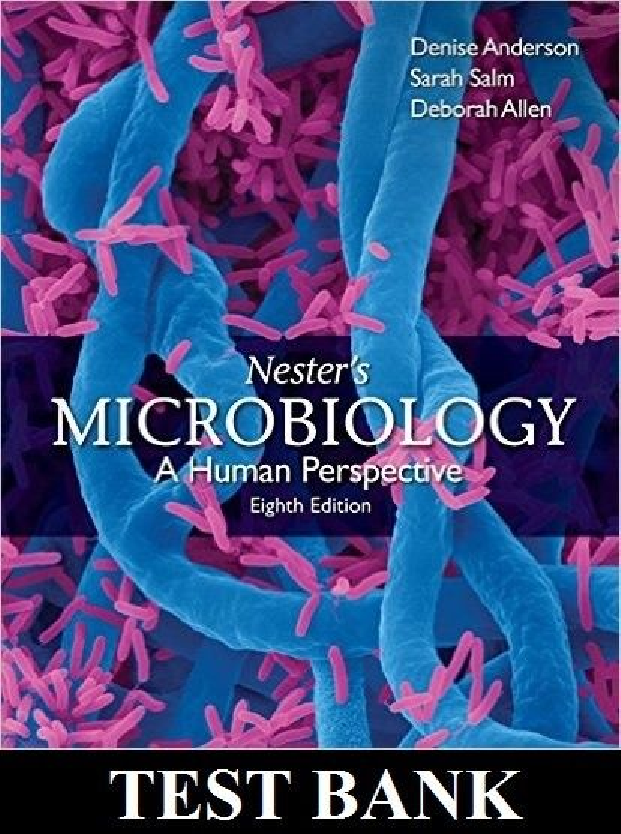
Reviews( 0 )
Document information
Connected school, study & course
About the document
Uploaded On
Sep 08, 2021
Number of pages
847
Written in
Additional information
This document has been written for:
Uploaded
Sep 08, 2021
Downloads
0
Views
111

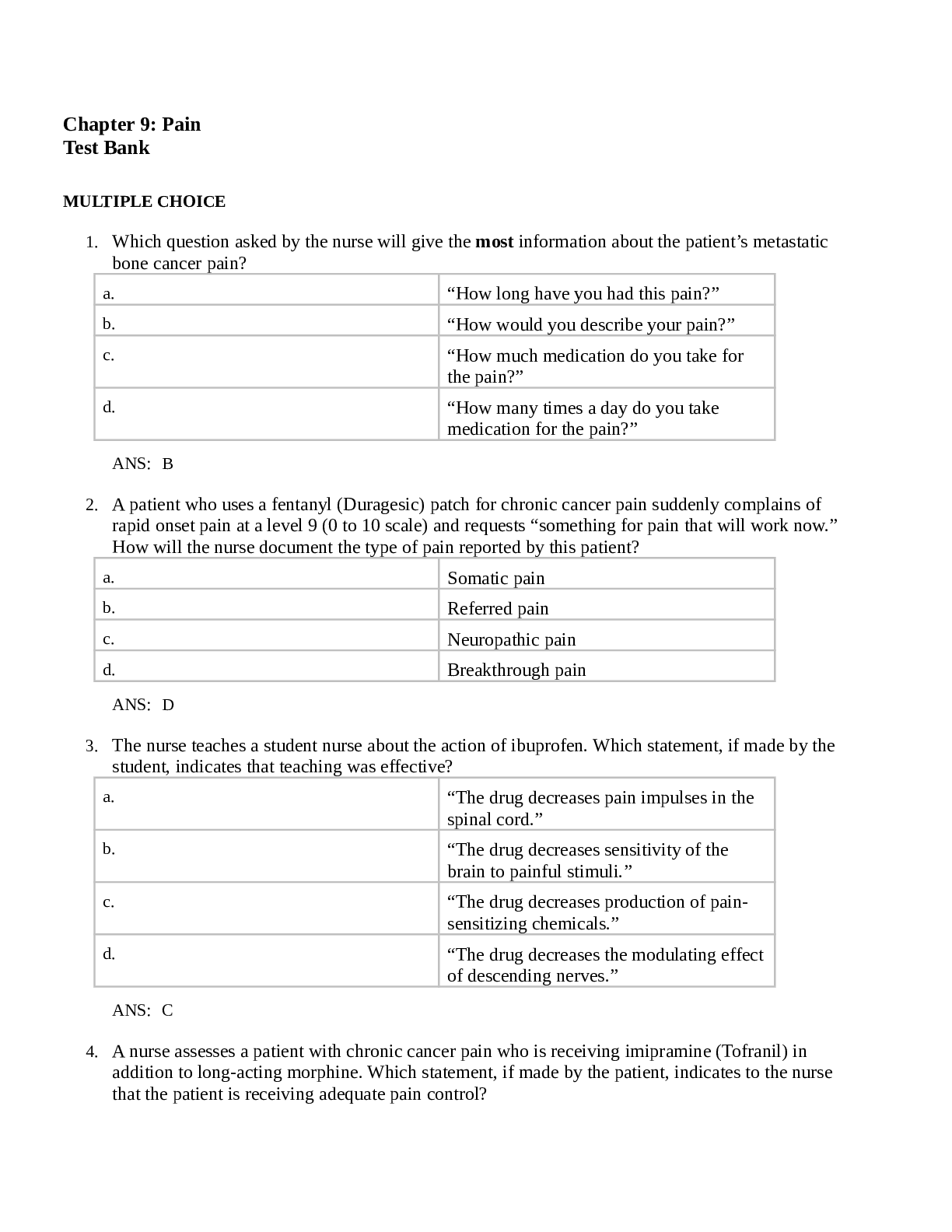
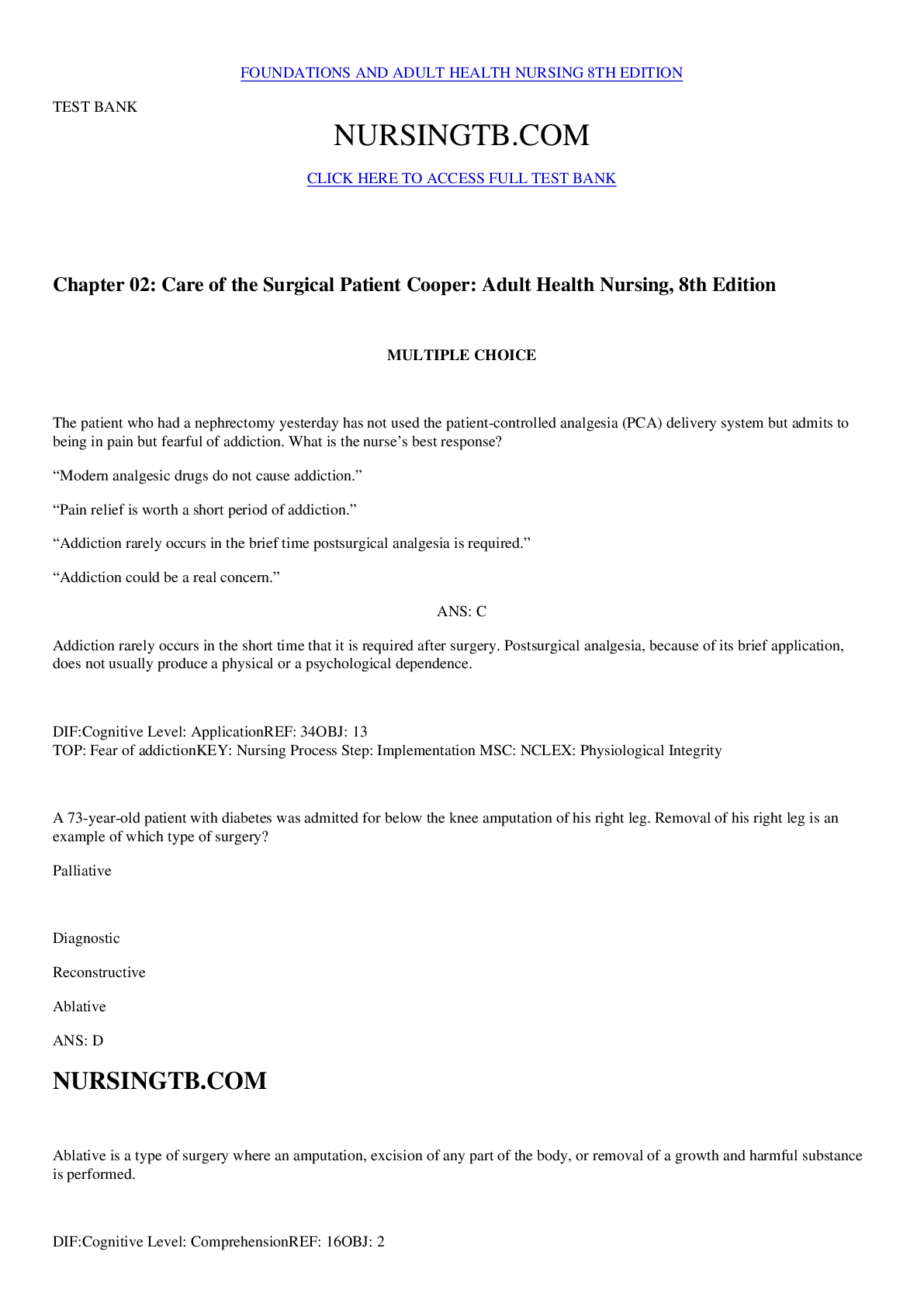
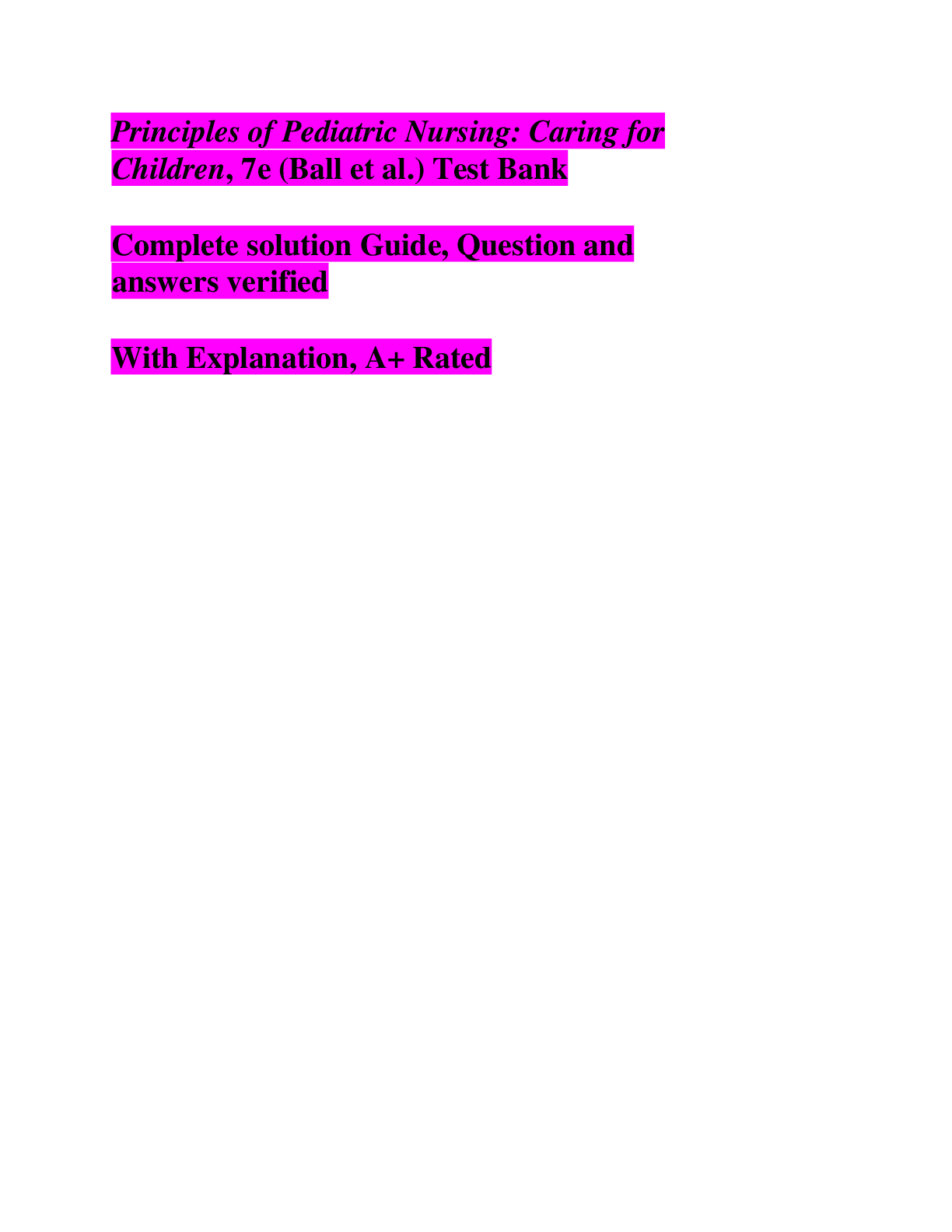

.png)

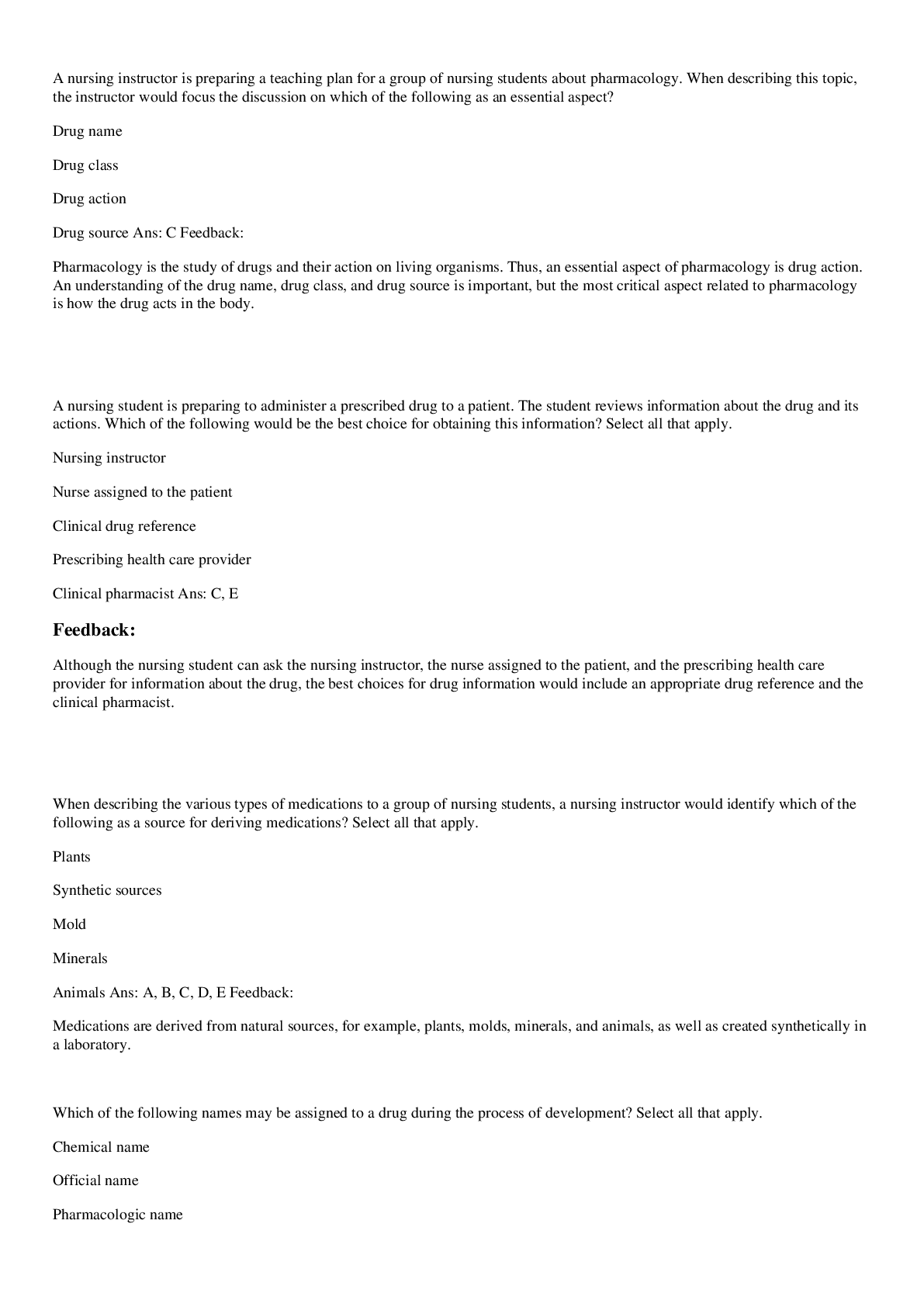

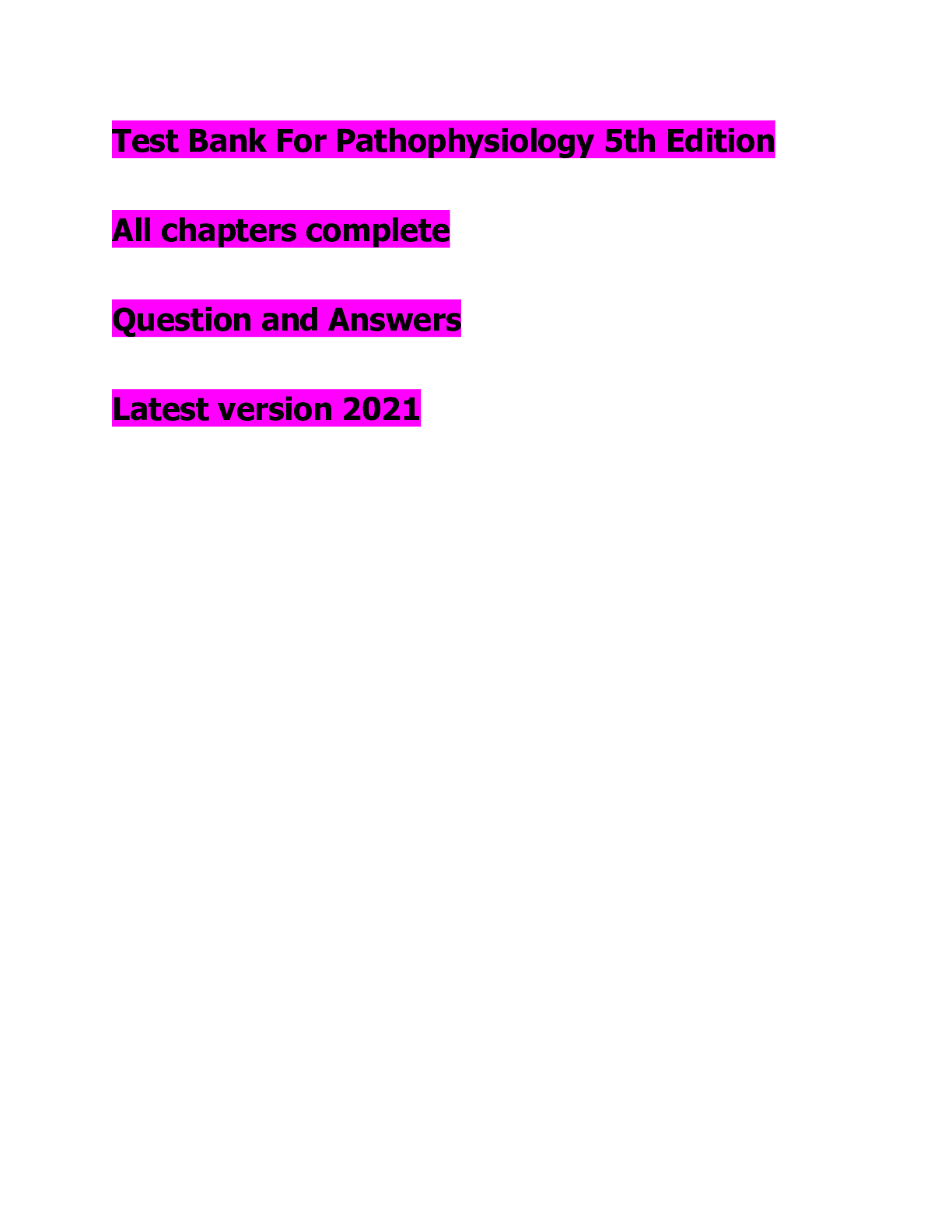
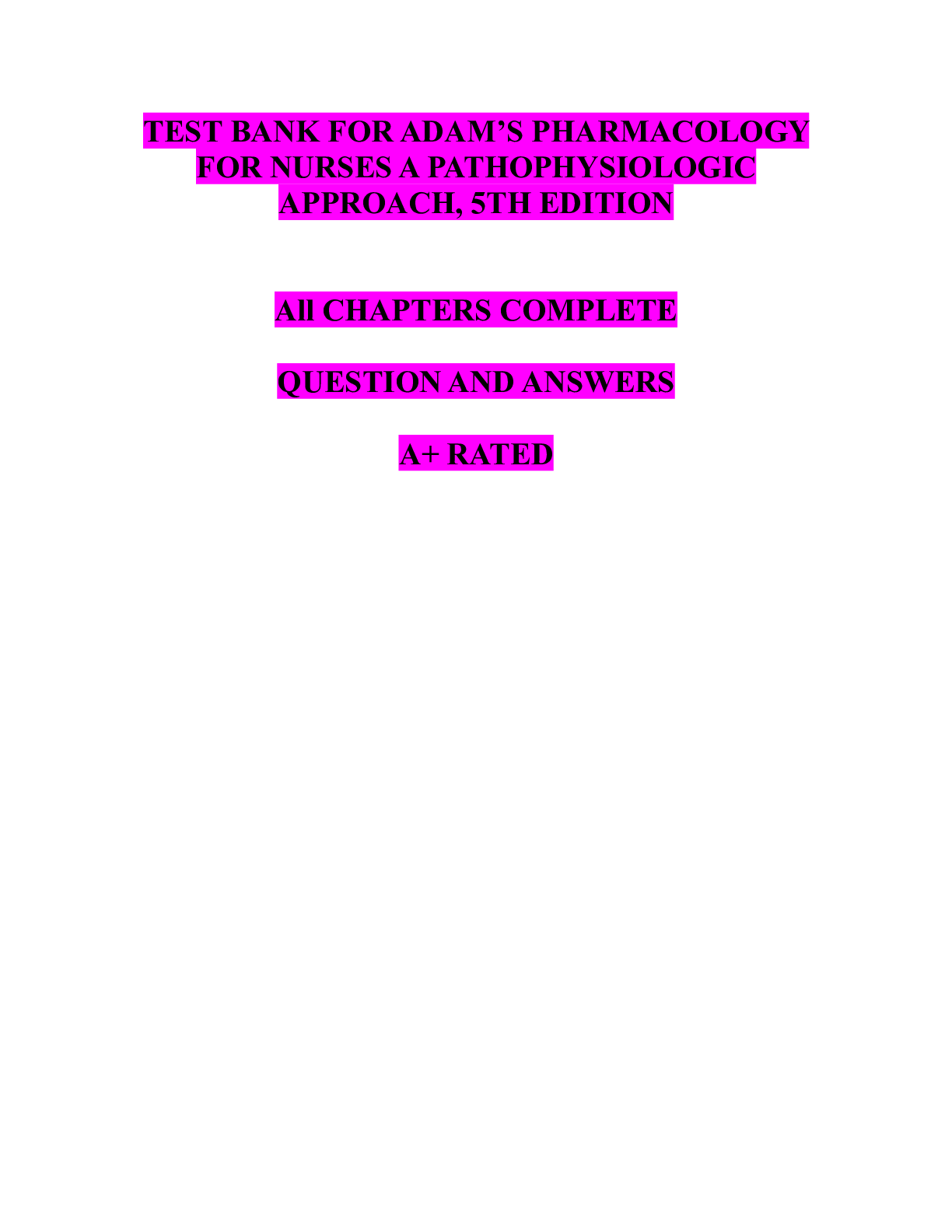
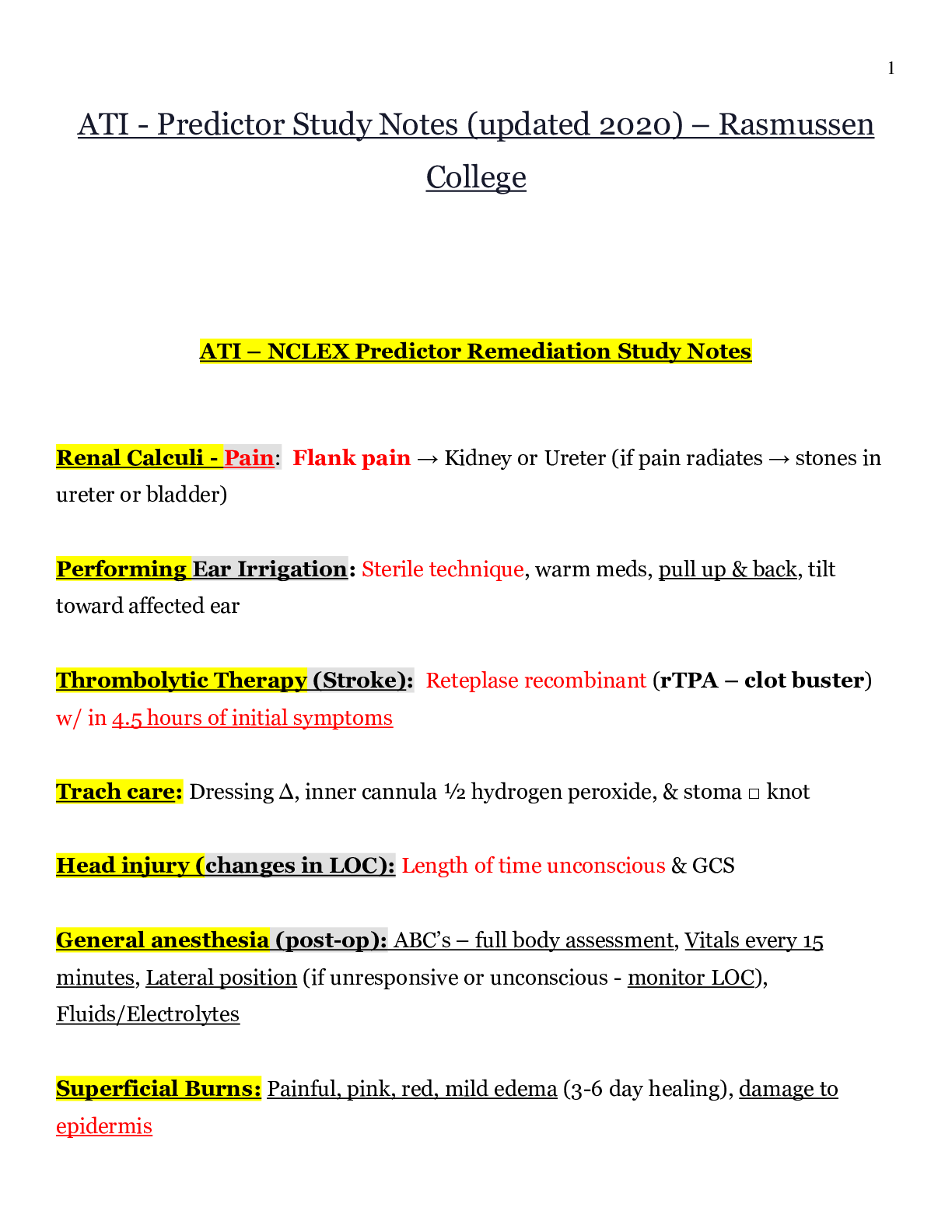

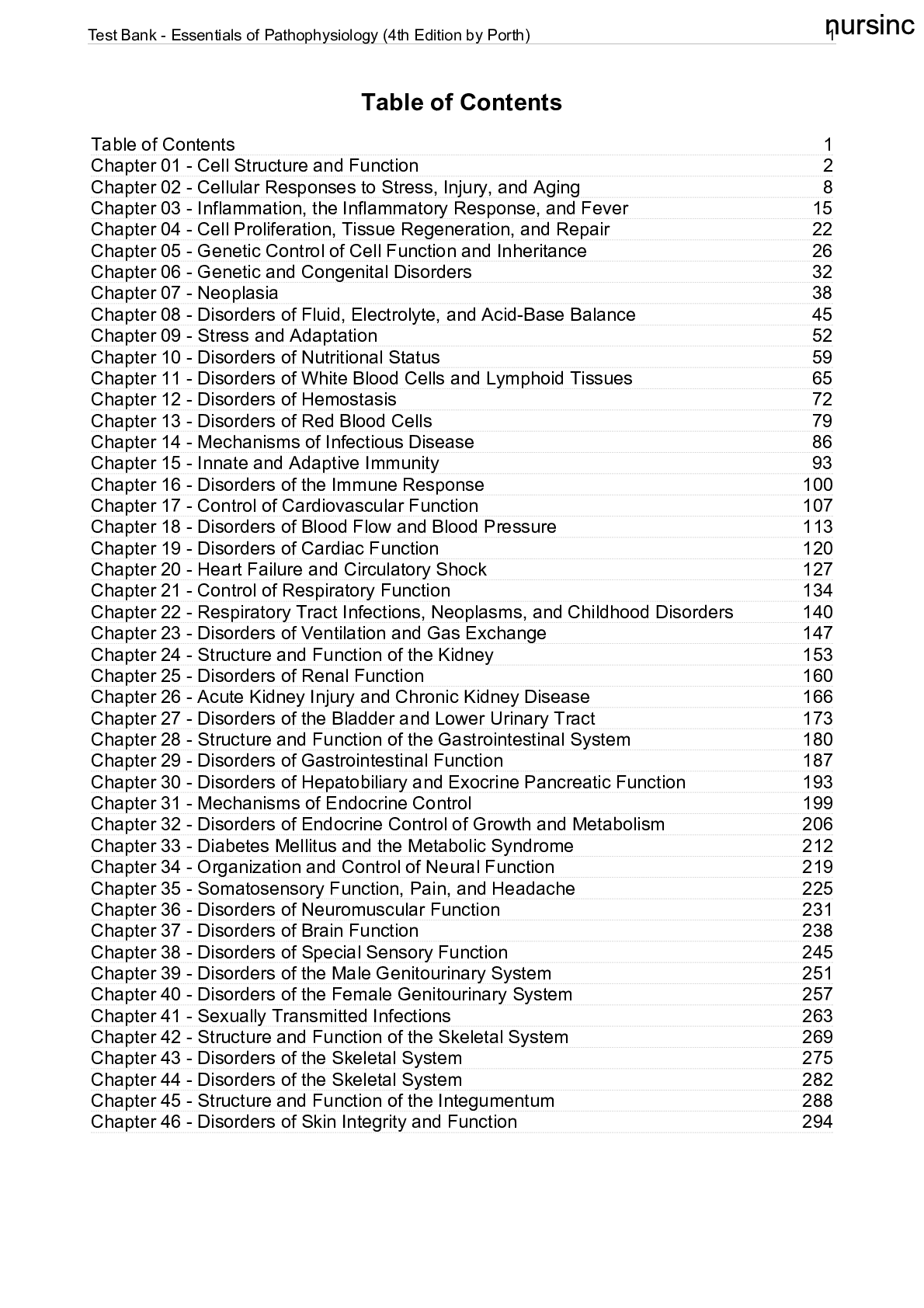

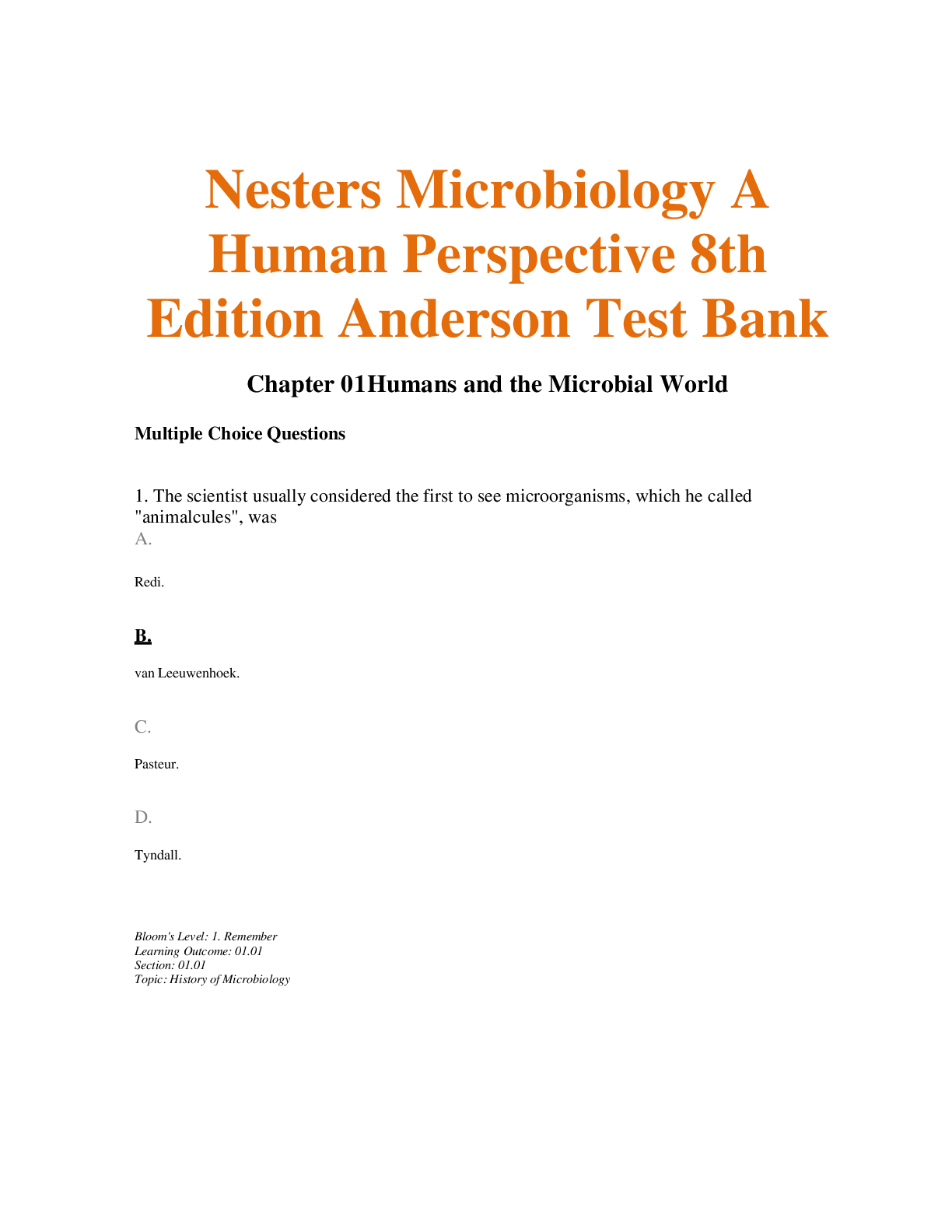
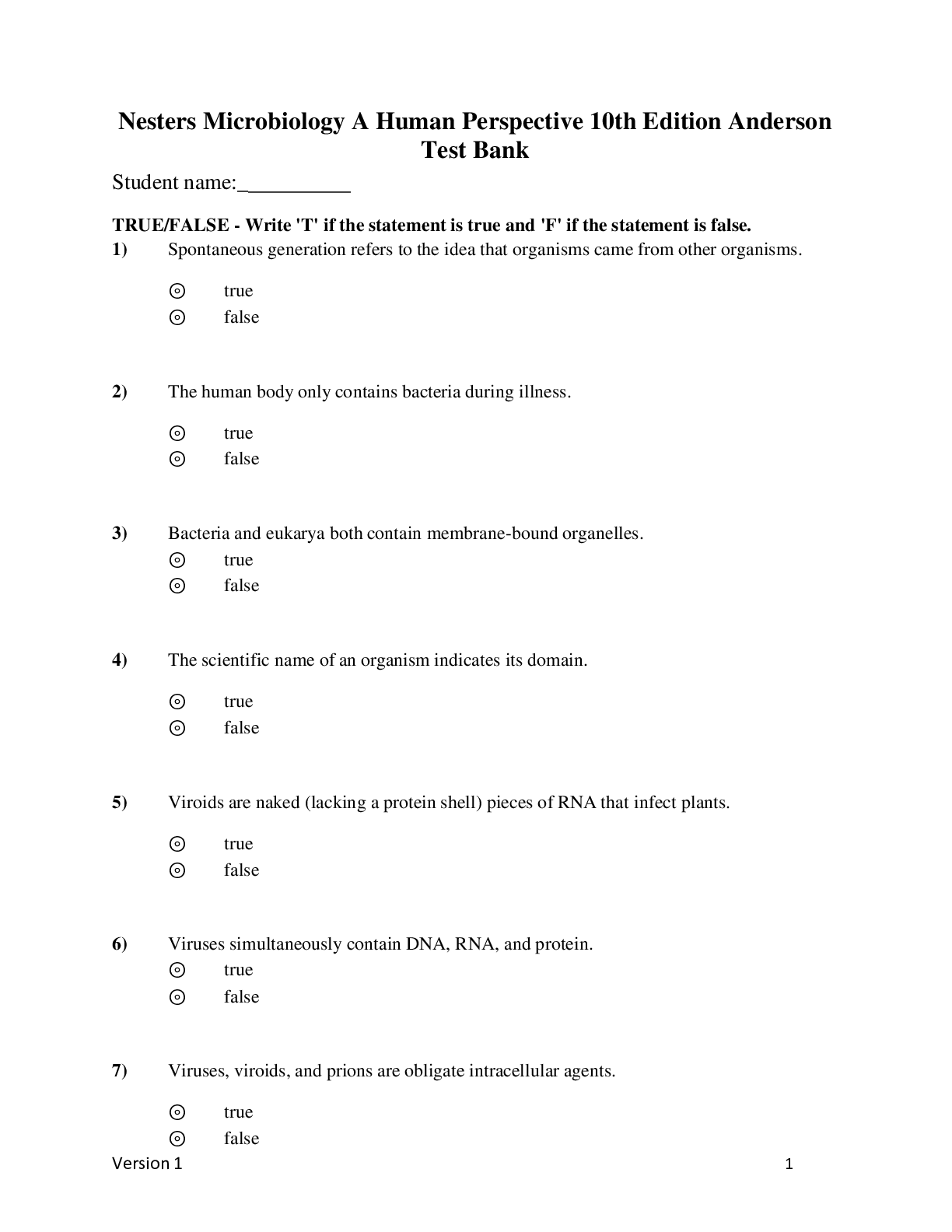
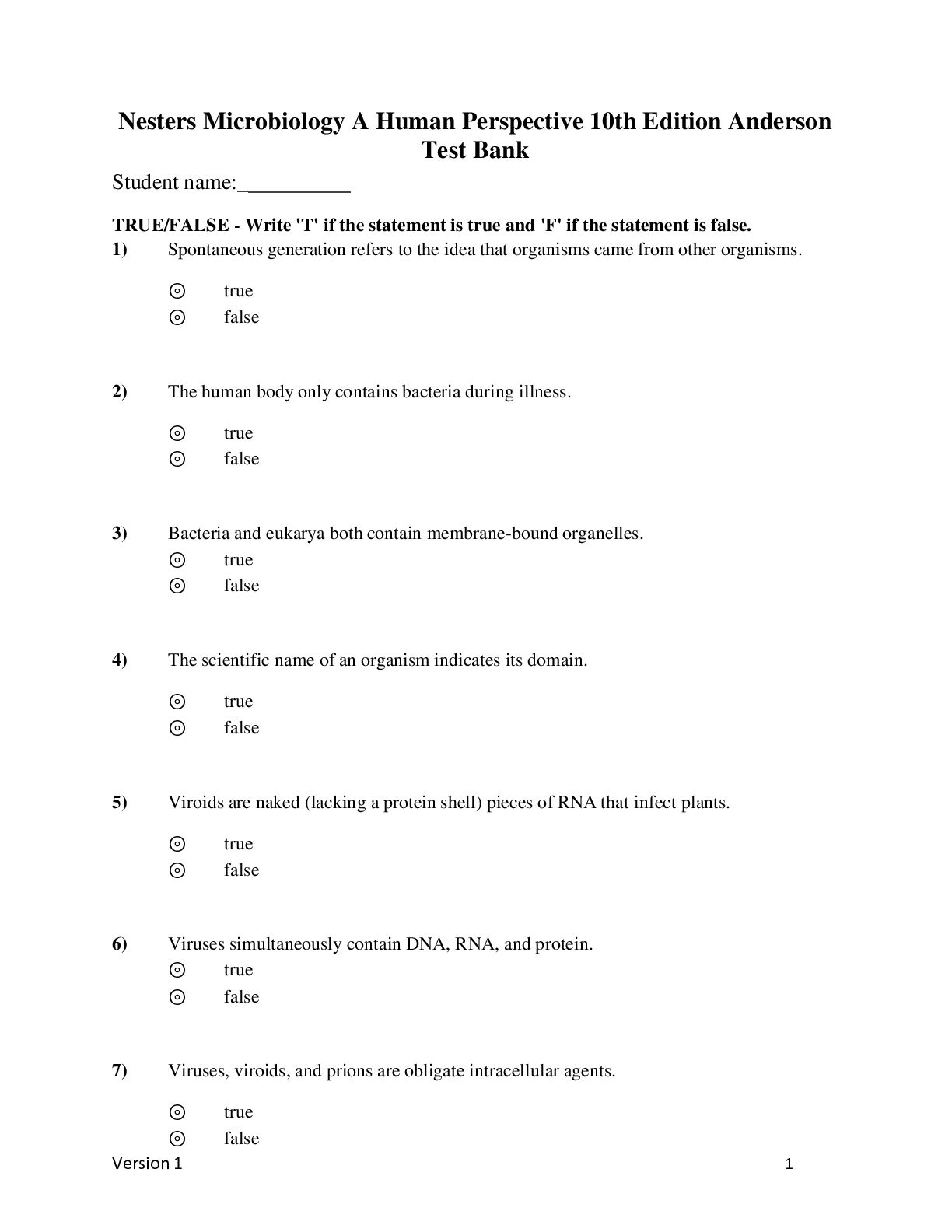
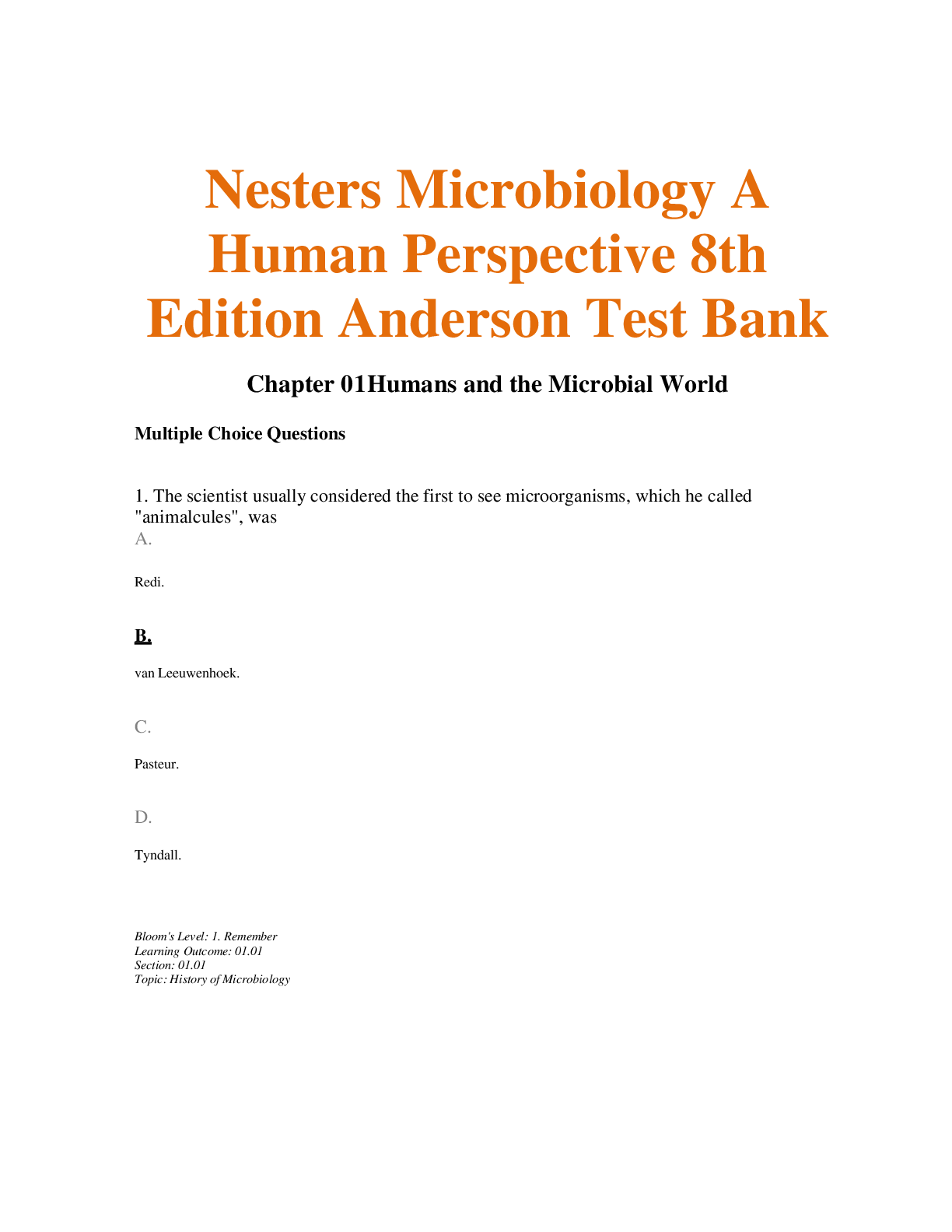
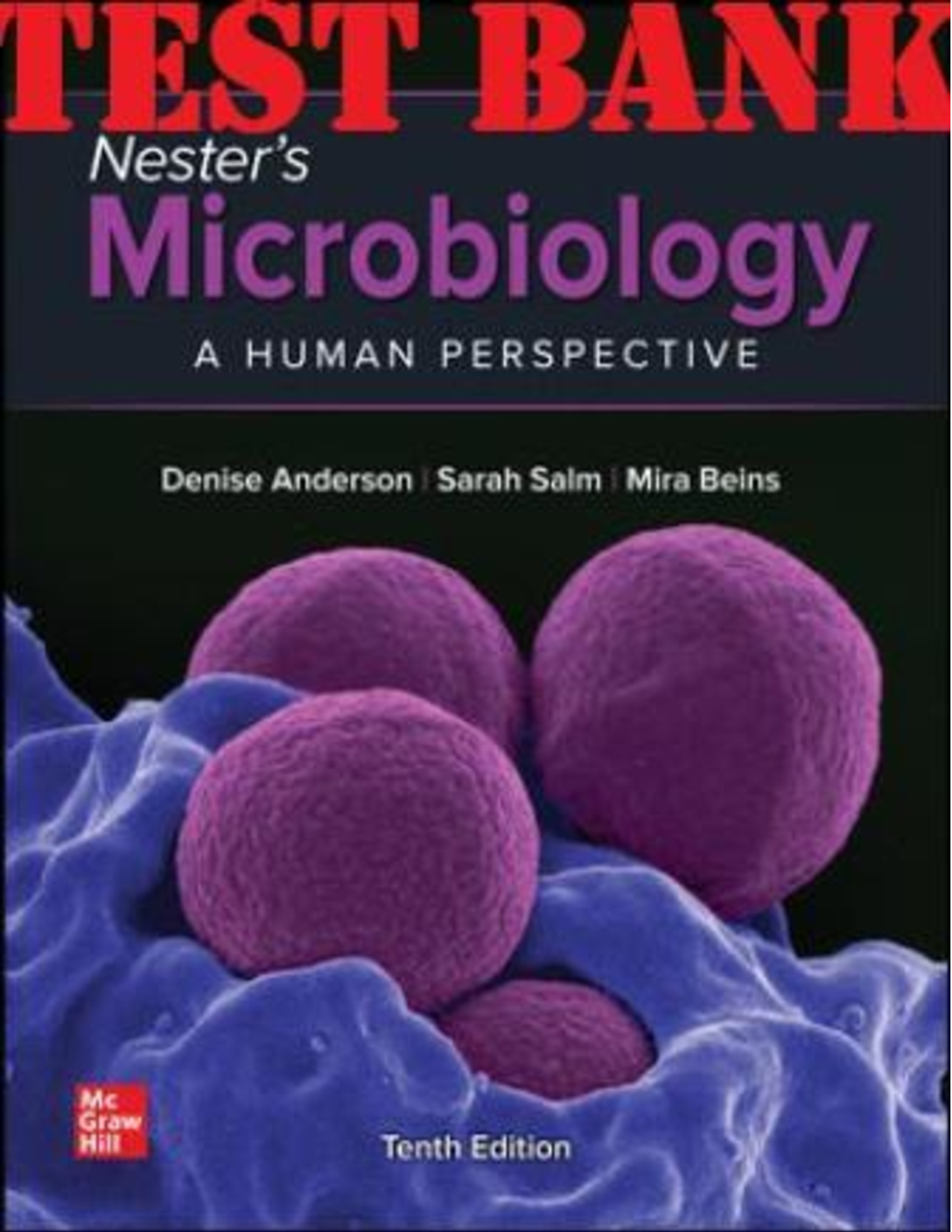

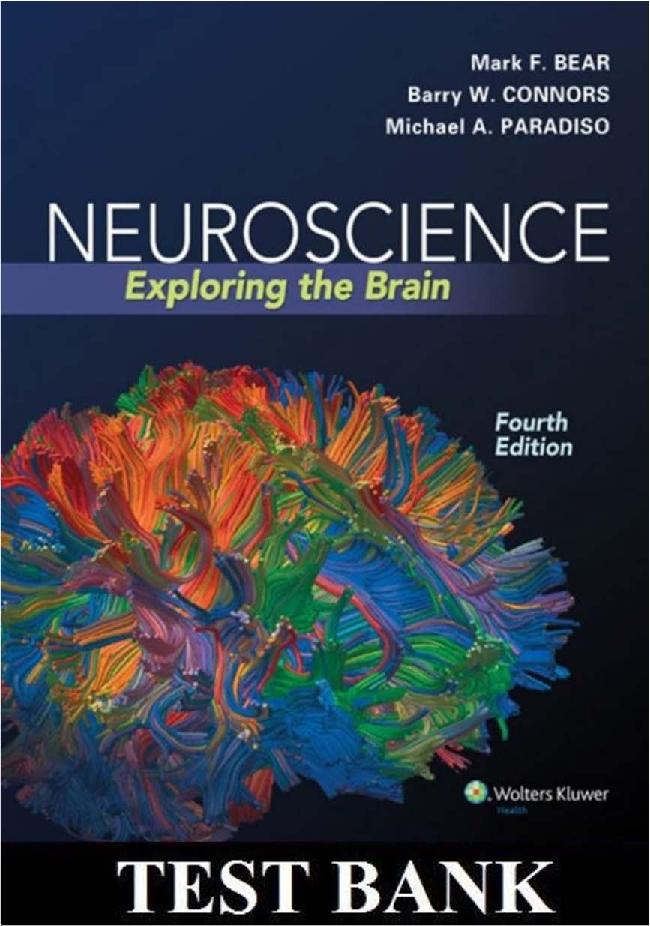


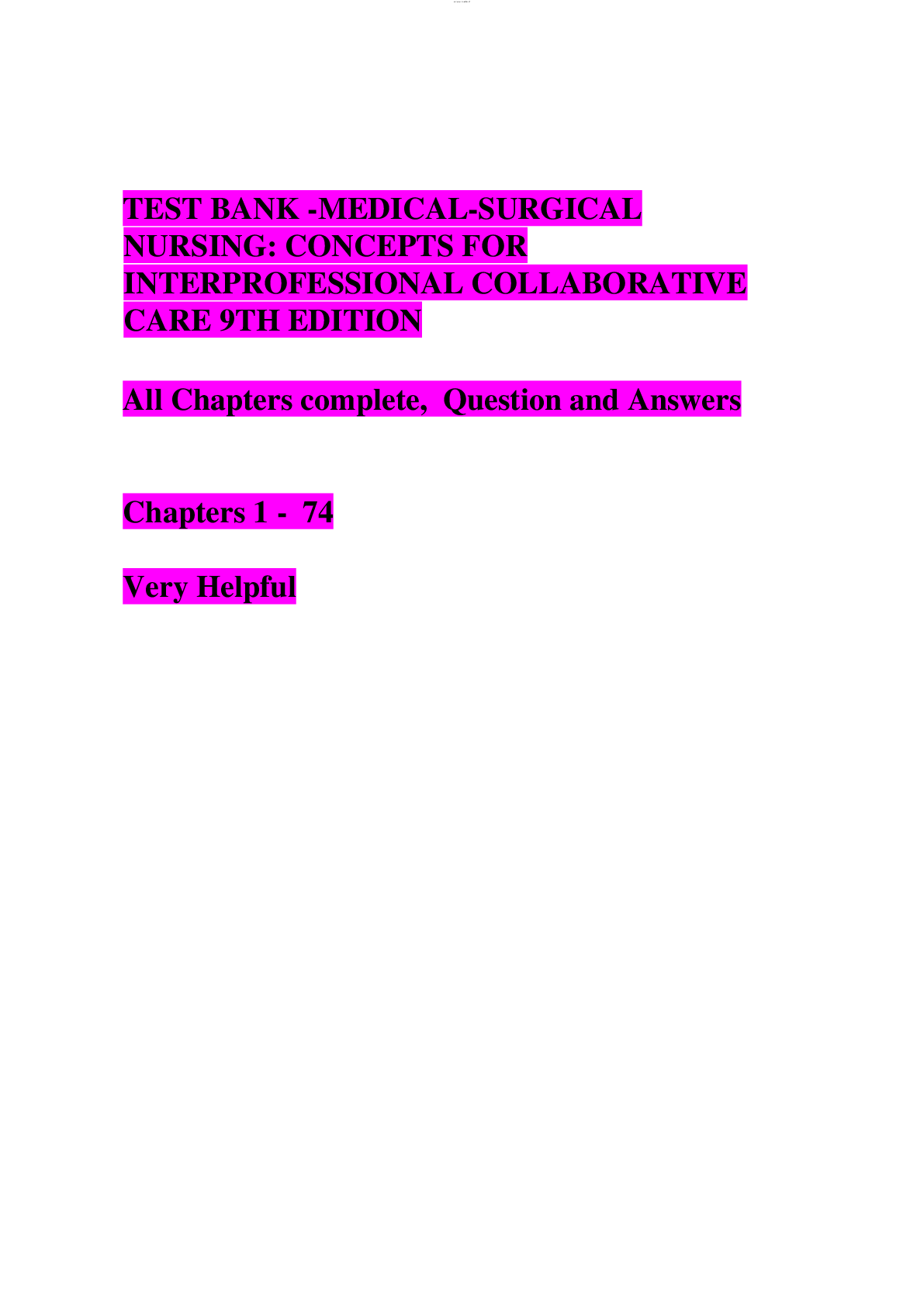
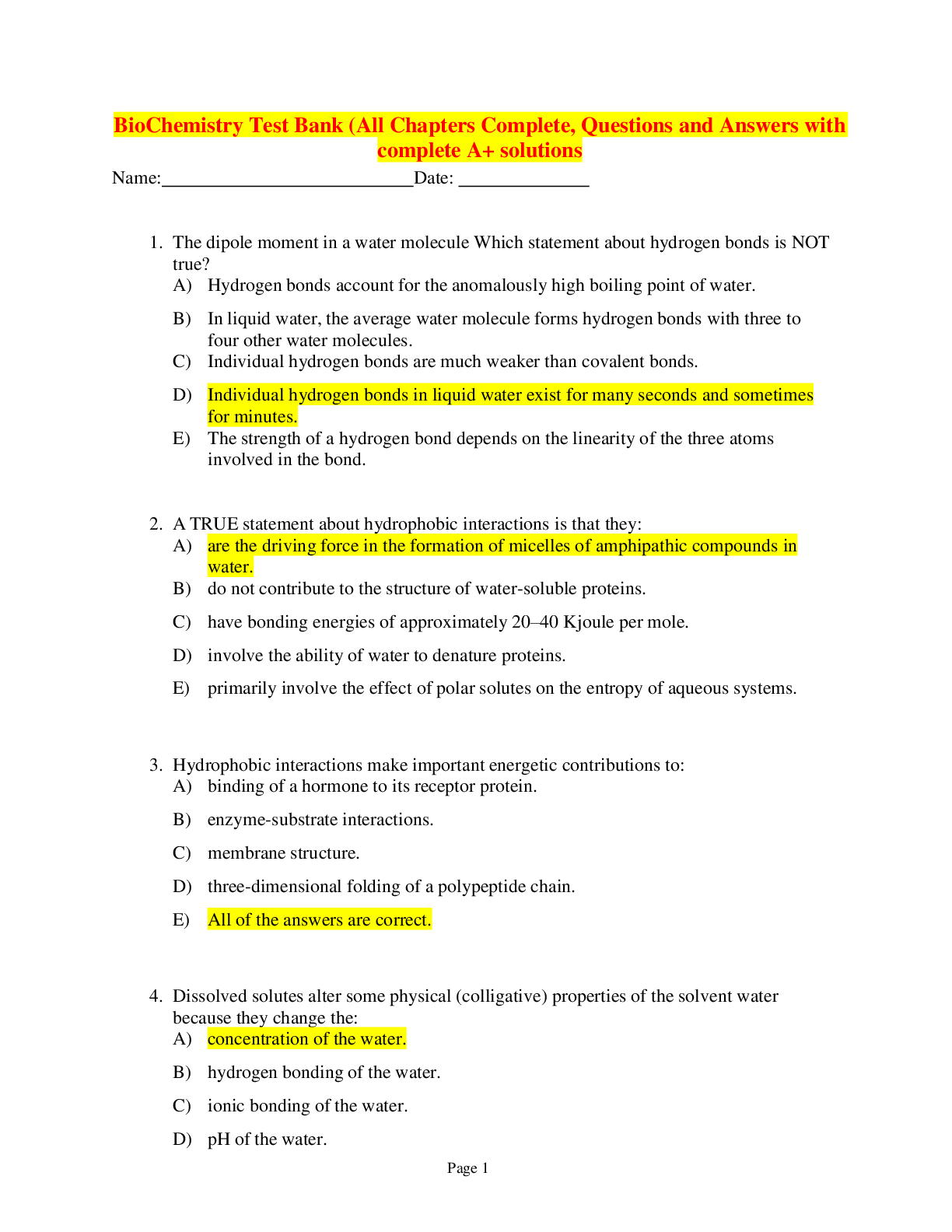
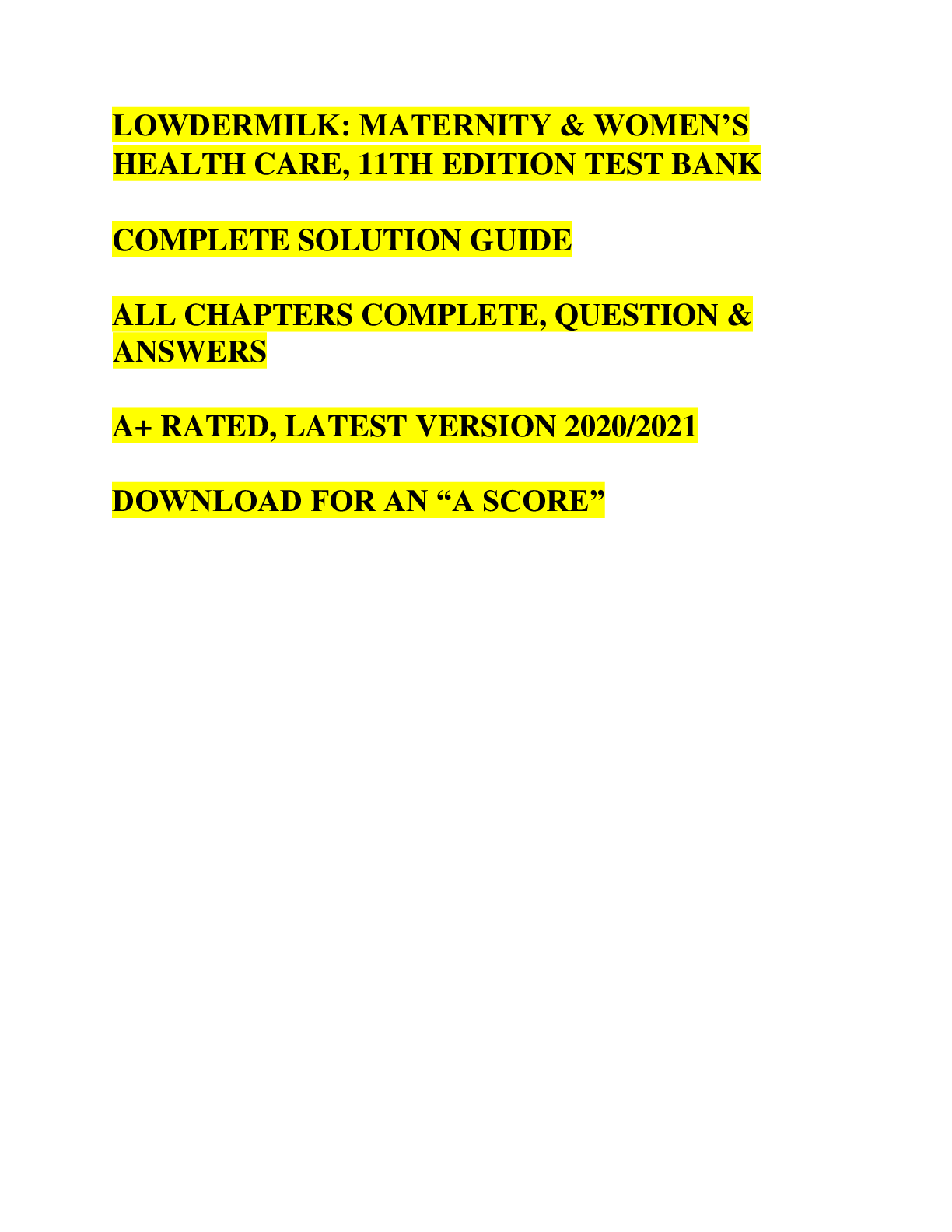
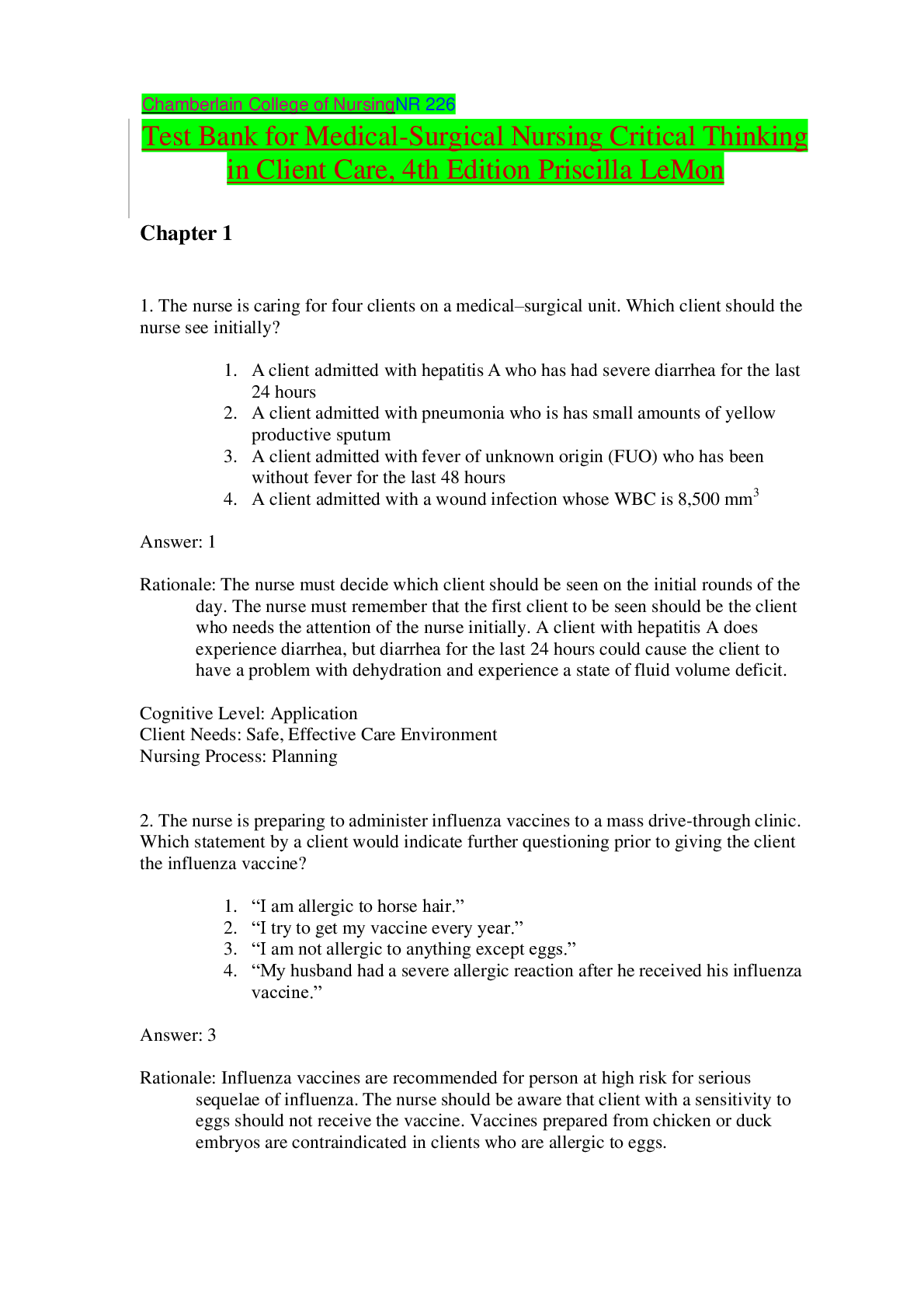
 Denise G.png)

